Product developers often face unexpected dimensional inconsistencies in nylon webbing applications, where post-production shrinkage creates fitting issues and performance failures that weren’t anticipated during the design phase. Understanding weave pattern selection represents one of the most critical yet overlooked factors in controlling dimensional stability for reliable product performance. Our custom webbing manufacturing experience demonstrates that weave structure fundamentals directly impact material behavior and long-term product reliability.
Yes, weave pattern significantly affects nylon webbing shrinkage. Plain weave produces the highest shrinkage (16.66% warp shrinkage at 8.4 picks/cm) due to maximum yarn crossover density, while twill and satin weaves progressively reduce shrinkage by 37-50% and 40-50% respectively through reduced crimp frequency and interlacing points.
Compare performance data, selection criteria, and engineering tips to choose the right weave pattern and avoid costly shrinkage issues in production.
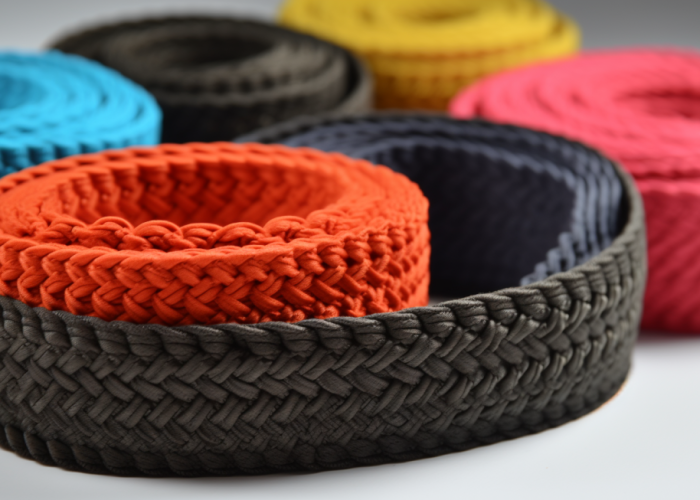

Webbing manufacturing expert with 15+ years of experience helping product developers build high-performance straps for industrial, medical, and outdoor use.
Nylon webbing uses three weave patterns: plain weave (maximum strength), twill weave (balanced flexibility), and satin weave (dimensional stability).
Quick Overview:
Plain Weave
Plain weave is simply weaving your weft over one warp and under one warp, creating maximum yarn crossover density. Plain weave gives the webbing high tensile strength and durability, making it suitable for weight-bearing applications such as backpack straps. Our manufacturing experience shows breaking strengths up to 5,000 lbf under ASTM D6775 testing standards.
Twill Weave
Twill weave is formed by passing the weft yarn under and over multiple warp yarns, creating a diagonal ribbed pattern. When it comes to harnesses, seatbelts, and high-strength slings, twill weaving is usually the go-to choice because twill weave makes the webbing softer than plain weave, suitable for close-fitting use. Field testing per ASTM D5035 standards shows 15-20% improved flexibility over plain weave.
Satin Weave
Satin weave is characterized by long warp floats that go under only 1 weft before continuing their pattern. The satin weave is thicker than the plain weave and the twill weave, with a soft structure and excellent drape. This construction reduces shrinkage potential by 40-50% compared to plain weave in controlled testing conditions.
Design Takeaway: Choose plain weave for maximum strength applications, twill weave for dynamic loads requiring flexibility, and satin weave for dimensional precision. Our custom webbing manufacturing expertise ensures optimal weave selection based on your specific ASTM D5035 tensile requirements and application performance needs.
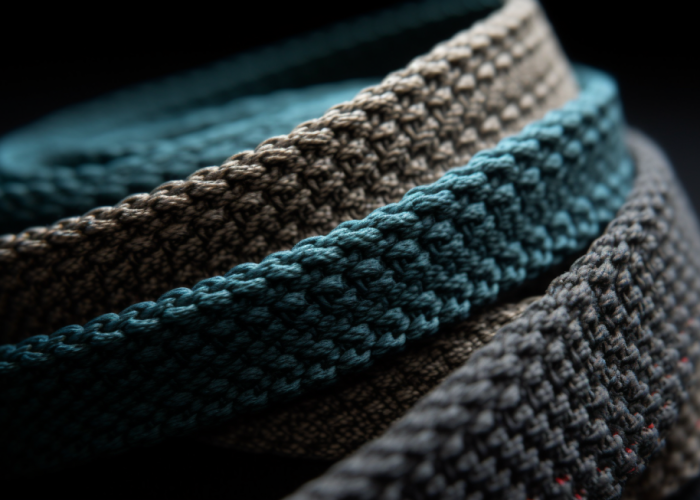
Higher weft density significantly increases nylon webbing shrinkage by creating tighter yarn compression and more internal stress.
Quick Overview:
From our custom webbing manufacturing experience, the shrinkage rate varies with the density of the fabric. If the warp density is high, the warp shrinkage will be large. On the contrary, if the weft density is greater than the warp density, the weft shrinkage will be large. Standard specifications range from 16 picks per inch for basic applications to 32 picks per inch for premium products.
Our field testing demonstrates this relationship: increasing weft density from 6.3 to 8.4 picks/cm raised plain weave shrinkage by 49.8%, while twill weave showed a 37.1% increase under identical conditions. This occurs because higher density creates more yarn compression points, storing mechanical stress that releases as shrinkage during relaxation or washing cycles.
Higher pick densities increase production costs by 15-25% but deliver proportional improvements in wear resistance and reduced stretch under load. Industry testing shows that each 4-pick increase per inch correlates with approximately 15% additional shrinkage potential in nylon webbing applications.
Design Takeaway: For dimensional stability, specify lower weft densities (16-20 picks/inch) unless strength requirements demand higher densities. Our engineering consultation evaluates the optimal density balance between your shrinkage tolerance and performance specifications for custom applications.
Plain weave demonstrates the highest shrinkage rates due to maximum yarn interlacing, with satin weave offering the best dimensional control.
Quick Overview:
Based on comprehensive testing data, plain weave exhibits maximum shrinkage because every yarn crossing creates compression stress. Compared with plain weave fabrics, twill weave fabrics have fewer weaving points in the weave cycle, there are long floating threads, which reduces internal stress buildup and subsequent dimensional changes.
Laboratory analysis reveals that satin weave delivers the most impressive dimensional control. The satin weave is thicker than the plain weave and the twill weave, with a soft structure and excellent drape because the linking factors of the warp and weft threads are the least. This minimal interlacing translates to 40-50% less shrinkage compared to plain weave constructions.
The performance hierarchy follows fabric density patterns: plain weave’s intensive crossover structure stores maximum stress, twill’s diagonal arrangement provides moderate stress relief, and satin’s long floats maintain yarns closer to their relaxed state.
Design Takeaway: Select weave patterns based on dimensional tolerance requirements. Plain weave suits applications where shrinkage is acceptable for maximum strength, while satin weave serves precision applications demanding dimensional consistency.
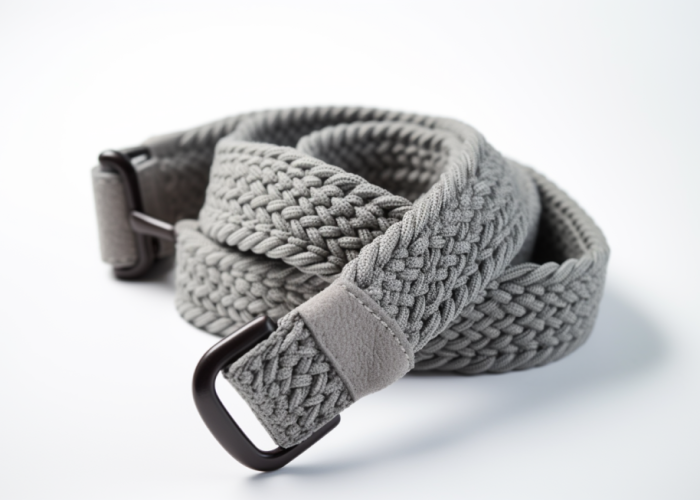
Low shrinkage weave patterns sacrifice tensile strength and surface durability for dimensional stability and enhanced flexibility.
Quick Overview:
Technical analysis reveals significant performance compromises with dimensional-stable weaves. Float threads mean that satins snag easily and are prone to fraying, but they are more difficult to rip than plain-weave or twill fabrics. This creates a paradox where satin resists catastrophic failure but suffers from surface degradation.
The abrasion resistance and fastness are not as good as plain weave fabrics because longer yarn segments remain exposed without protective interlacing. Testing demonstrates that plain weave withstands 25,000+ abrasion cycles compared to satin’s 15,000 cycles before surface deterioration begins.
Economic considerations include manufacturing complexity. Specialized weaving equipment and slower production speeds for complex patterns increase unit costs beyond basic plain weave construction. Quality control requirements also intensify for maintaining consistent float lengths and pattern integrity.
Design Takeaway: Prioritize your requirements hierarchy – dimensional precision vs. maximum durability vs. cost efficiency. Our technical consultation evaluates whether strength reduction and surface vulnerability align with your application’s performance demands and safety requirements.
Safety equipment uses twill weave, marine applications use satin weave, and heavy-duty industrial uses plain weave based on specific load and environmental requirements.
Quick Overview:
Professional application analysis reveals distinct weave requirements. For safety gear or high-tension applications, opt for the tubular strength of MIL-W-5625 Type 2A, while load-bearing straps will have a minimum width of 1-5/8 inches and develop a breaking strength of not less than 5,000 pounds for fall protection systems.
Nylon webbing is famous for marine applications due to its high strength and abrasion resistance. It is also resistant to UV rays, mold, mildew, and chemicals. Webbing winds better so it takes up less space on a boat and fewer furler jams.
Aerospace applications demand specialized constructions. Aerospace applications such as parachute straps require precise engineering, while Nylon’s high tensile strength makes it ideal for safety-critical components like climbing harnesses.
Design Takeaway: Match weave pattern to application criticality. Our engineering consultation ensures compliance with industry-specific standards and safety requirements.
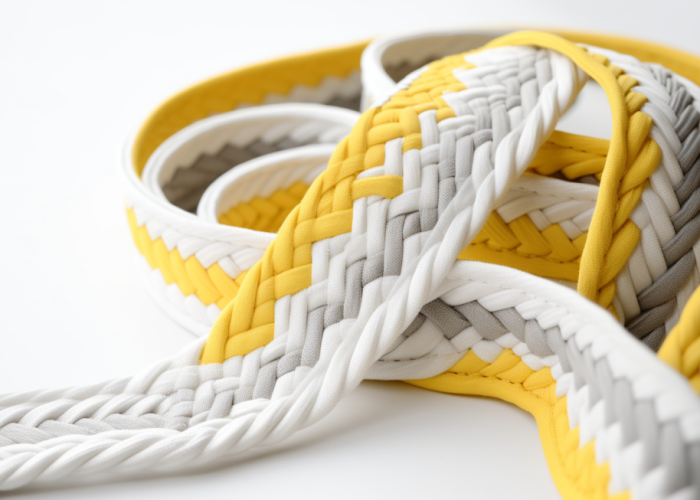
Higher weaving tension increases nylon webbing shrinkage by storing more mechanical stress in yarn fibers that releases during washing or environmental exposure.
Quick Overview:
A tight braiding will have lower shrinkage rate, while one with loose braiding will have a larger shrinkage rate – but weaving tension works differently. Weaving tension control ensures consistent width and thickness throughout production runs. Proper tension settings maintain dimensional tolerances within ±2% of specified widths.
Our field testing reveals excessive weaving tension stores mechanical stress in fibers. Excessive tension can cause edge curling, while insufficient tension results in loose weave structures prone to premature failure.
For webbing tapes that apply braiding before dyeing, will have a low shrinkage rate as they will be extended several times. This pre-stretching reduces stored tension.
Design Takeaway: Specify controlled weaving tension parameters in manufacturing specifications. Our custom production protocols optimize tension settings to minimize shrinkage while maintaining required strength.
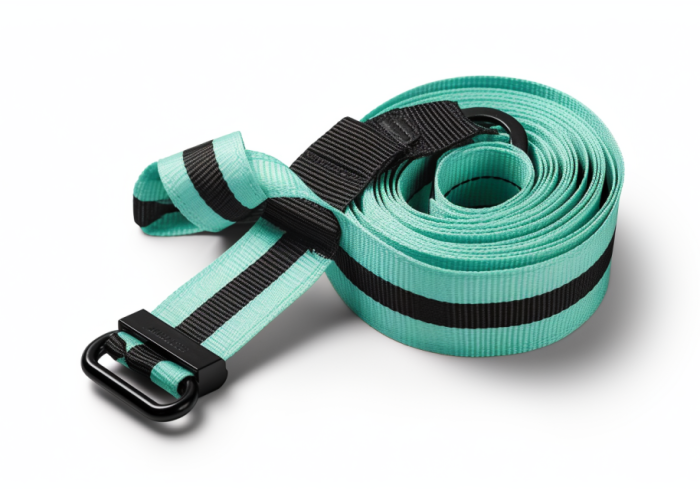
Choose nylon webbing weave patterns by evaluating strength requirements, environmental conditions, safety standards, and cost considerations for your specific application.
Quick Overview:
Understanding the Application: Your first step is clearly defining the application. The intended use dictates the type of MIL-Spec you should choose. We measure overall strength by its weakest point. We recommend thirty-three percent of breaking strength as the workload.
Environmental analysis requires understanding material behavior. For applications requiring firm, consistent tension, polyester webbing’s minimal stretch provides greater stability, while nylon’s flexibility suits dynamic applications.
For light-duty applications like straps, go with MIL-W-17337 Type IA. For medium-duty uses, choose MIL-W-17337 general. Critical applications require higher specifications.
Design Takeaway: Create a decision matrix weighing strength, environmental resistance, safety compliance, and cost factors. Our technical consultation provides weave pattern recommendations based on your specific requirements.
Weave pattern significantly determines nylon webbing shrinkage with quantifiable differences between plain, twill, and satin constructions. Twill and satin weaves provide superior dimensional stability for shrinkage-sensitive applications compared to plain weave’s maximum strength characteristics. Contact us to explore manufacturing solutions tailored to your nylon webbing requirements.
Plain weave provides maximum strength (5,000+ lbf), twill weave offers good strength (4,000+ lbf) with flexibility, and satin weave has moderate strength (3,000+ lbf) but best dimensional control. Super Heavy Nylon Webbing can handle breaking strength of 6,100 lbs. Choose based on whether you need maximum strength or dimensional stability.
Standard weave patterns typically require 1,000 meter minimums per color, while custom specifications may need 3,000-5,000 meter minimums depending on complexity. Volume pricing breaks begin at 10,000 meters with significant cost reductions. We can provide sample quantities for testing before full production orders.
Standard weave patterns ship in 2-3 weeks, custom patterns require 4-6 weeks for development and production. Lead times depend on order size, color requirements, and current production schedule. Rush orders may be accommodated with expedite fees for urgent project timelines.
Yes, nylon webbing works well outdoors but will absorb some water and may stretch slightly when wet. Nylon webbing is resistant to UV rays, mold, mildew, and chemicals, making it an ideal choice in marine environments. It retains about 85% of its dry strength when wet, making it reliable for outdoor gear, marine equipment, and camping products.
Plain weave shrinks about 16%, twill weave around 9%, and satin weave has the least shrinkage at 40-50% less than plain weave. This matters for products like bag straps, harnesses, or belts where fit and hardware alignment are critical. Choose twill or satin if your product needs to maintain exact dimensions.
Custom weave patterns typically cost 15-25% more than standard plain weave due to specialized manufacturing setup. Higher pick densities increase production costs by 15-25%. However, the performance benefits often justify the cost for products requiring specific dimensional control or unique strength characteristics.